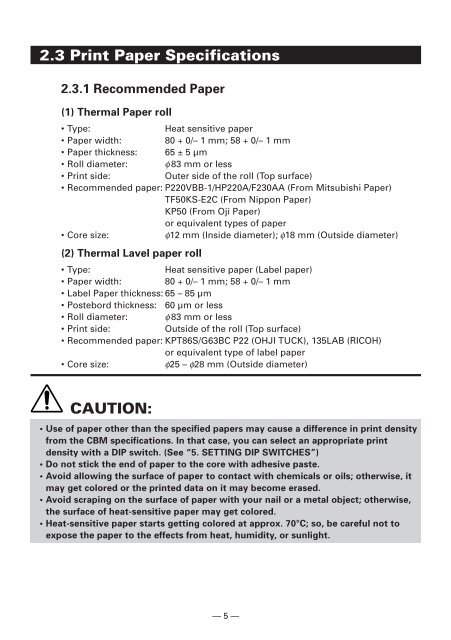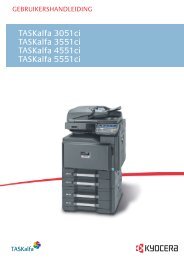1 Turn off the power of the printer. - Van Mechelen
1 Turn off the power of the printer. - Van Mechelen
1 Turn off the power of the printer. - Van Mechelen
- No tags were found...
You also want an ePaper? Increase the reach of your titles
YUMPU automatically turns print PDFs into web optimized ePapers that Google loves.
2.3 Print Paper Specifications<br />
2.3.1 Recommended Paper<br />
(1) Thermal Paper roll<br />
• Type:<br />
Heat sensitive paper<br />
• Paper width: 80 + 0/– 1 mm; 58 + 0/– 1 mm<br />
• Paper thickness: 65 ± 5 µm<br />
• Roll diameter: φ 83 mm or less<br />
• Print side:<br />
Outer side <strong>of</strong> <strong>the</strong> roll (Top surface)<br />
• Recommended paper: P220VBB-1/HP220A/F230AA (From Mitsubishi Paper)<br />
TF50KS-E2C (From Nippon Paper)<br />
KP50 (From Oji Paper)<br />
or equivalent types <strong>of</strong> paper<br />
• Core size:<br />
φ12 mm (Inside diameter); φ18 mm (Outside diameter)<br />
(2) Thermal Lavel paper roll<br />
• Type:<br />
Heat sensitive paper (Label paper)<br />
• Paper width: 80 + 0/– 1 mm; 58 + 0/– 1 mm<br />
• Label Paper thickness: 65 – 85 µm<br />
• Postebord thickness: 60 µm or less<br />
• Roll diameter: φ 83 mm or less<br />
• Print side:<br />
Outside <strong>of</strong> <strong>the</strong> roll (Top surface)<br />
• Recommended paper: KPT86S/G63BC P22 (OHJI TUCK), 135LAB (RICOH)<br />
or equivalent type <strong>of</strong> label paper<br />
• Core size:<br />
φ25 – φ28 mm (Outside diameter)<br />
CAUTION:<br />
• Use <strong>of</strong> paper o<strong>the</strong>r than <strong>the</strong> specified papers may cause a difference in print density<br />
from <strong>the</strong> CBM specifications. In that case, you can select an appropriate print<br />
density with a DIP switch. (See “5. SETTING DIP SWITCHES”)<br />
• Do not stick <strong>the</strong> end <strong>of</strong> paper to <strong>the</strong> core with adhesive paste.<br />
• Avoid allowing <strong>the</strong> surface <strong>of</strong> paper to contact with chemicals or oils; o<strong>the</strong>rwise, it<br />
may get colored or <strong>the</strong> printed data on it may become erased.<br />
• Avoid scraping on <strong>the</strong> surface <strong>of</strong> paper with your nail or a metal object; o<strong>the</strong>rwise,<br />
<strong>the</strong> surface <strong>of</strong> heat-sensitive paper may get colored.<br />
• Heat-sensitive paper starts getting colored at approx. 70°C; so, be careful not to<br />
expose <strong>the</strong> paper to <strong>the</strong> effects from heat, humidity, or sunlight.<br />
— 5 —





